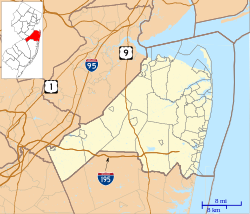| Sandy Hook Proving Ground | |
|---|---|
United States | |
| Sandy Hook Near Atlantic Highlands, New Jersey in United States | |
 Entrance (1911) | |
| Coordinates | 40°28′2.852″N 73°59′57.203″W / 40.46745889°N 73.99922306°W |
| Type | Proving ground |
| Site information | |
| Owner | United States Department of War |
| Operator | |
| Controlled by | U.S. Ordnance Department |
| Open to the public | Yes, with restrictions |
| Condition | Poor |
| Adjoining facility | Fort Hancock |
| Site history | |
| Built | August 7, 1874 |
| Built by | |
| In use | 1876-1919 |
| Fate | Facilities relocated; buildings abandoned |
| Test information | |
| Other tests | Artillery |
| Remediation | None |
Fort Hancock and the Sandy Hook Proving Ground Historic District | |
| Visitation | 6,021,713 (2014)[1] |
| Part of | Fort Hancock and the Sandy Hook Proving Ground Historic District (ID80002505) |
| Significant dates | |
| Designated NHL | December 17, 1982 |
| Designated CP | April 24, 1980 |
The Sandy Hook Proving Ground was a military facility along the Atlantic coast of New Jersey established by the Secretary of War on August 7, 1874, to serve as the United States Army's first proving ground for the testing of ordnance and materiel. The facility was located at Sandy Hook, a narrow coastal spit of land, approximately 6 miles (9.7 km) in length and 0.5 miles (varying between 0.1 and 1 miles) wide, in Middletown Township in Monmouth County. The facility was operated in conjunction with the adjoining Fort Hancock. Essentially abandoned in 1919 for a larger facility, the area was left to degrade and most of the structures still remain today. The proving ground and parts of Fort Hancock are now property of the National Park Service and mostly closed to the public.
- ^ "Annual Recreation Visitation Report by Years: 2004 to 2014". NPS Stats National Park Service Visitor Use Statistics. National Park Service. Retrieved 28 December 2015.
